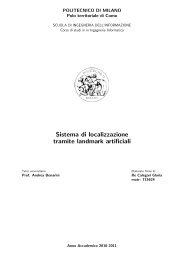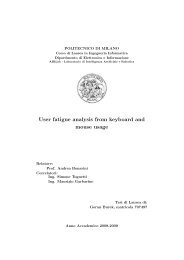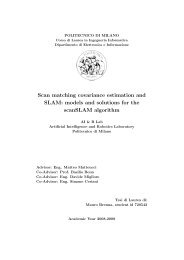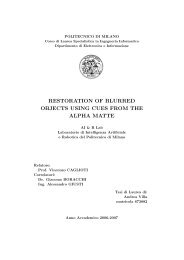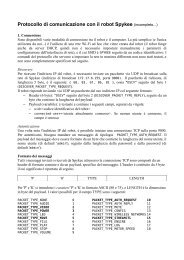Submitted version of the thesis - Airlab, the Artificial Intelligence ...
Submitted version of the thesis - Airlab, the Artificial Intelligence ...
Submitted version of the thesis - Airlab, the Artificial Intelligence ...
Create successful ePaper yourself
Turn your PDF publications into a flip-book with our unique Google optimized e-Paper software.
5.2. Color Definition 59<br />
warmer (yellow) <strong>the</strong> light, <strong>the</strong> lower <strong>the</strong> color temperature; <strong>the</strong> cooler <strong>the</strong><br />
light (blue), <strong>the</strong> higher <strong>the</strong> color temperature.<br />
Color Temperature Light Source<br />
1000-2000 K Candle light<br />
2500-3500 K Tungsten Bulb (household variety)<br />
3000-4000 K Sunrise/Sunset (clear sky)<br />
4000-5000 K Fluorescent Lamps<br />
5000-5500 K Electronic Flash<br />
5000-6500 K Daylight with Clear Sky (sun overhead)<br />
6500-8000 K Moderately Overcast Sky<br />
9000-10000 K Shade or Heavily Overcast Sky<br />
Color temperature is also important for cameras. The camera manufacturers<br />
knew that <strong>the</strong> color <strong>of</strong> <strong>the</strong> light would affect <strong>the</strong> colors delivered by<br />
<strong>the</strong> camera. Therefore, <strong>the</strong>y decided to deal with <strong>the</strong> problem by designing<br />
<strong>the</strong> cameras to automatically measure <strong>the</strong> light temperature and to make<br />
adjustments as <strong>the</strong> light changes color. That is why we can shoot in <strong>the</strong> relatively<br />
neutral light with camera in <strong>the</strong> afternoon and <strong>the</strong>n shoot <strong>the</strong> next<br />
day in <strong>the</strong> cool light <strong>of</strong> early morning and still, probably, get reasonable<br />
colors in both situations even though <strong>the</strong> color <strong>of</strong> <strong>the</strong> light was different.<br />
Cameras correct for <strong>the</strong> change in light temperature, using white balance.<br />
With auto white balance, <strong>the</strong> camera attempts to determine <strong>the</strong> color<br />
temperature <strong>of</strong> <strong>the</strong> light, and automatically adjusts for that color temperature.<br />
Auto white balance works reasonably well under <strong>the</strong> following conditions:<br />
• The application does not require absolute maximum color accuracy<br />
• There is not a preponderance <strong>of</strong> one color in <strong>the</strong> scene being photographed<br />
• Adjustments for <strong>the</strong> color temperature <strong>of</strong> <strong>the</strong> light<br />
Asmentionedin<strong>the</strong>previousparagraph, inautowhitebalancemode,<strong>the</strong><br />
cameradoesits besttodetermine<strong>the</strong>color <strong>of</strong><strong>the</strong>light andmakeappropriate<br />
adjustments. However, <strong>the</strong> methodology that is used to do this requires<br />
that certain assumptions be made. These assumptions do not always match<br />
perfectly <strong>the</strong> scene being photographed. As a consequence, <strong>the</strong> auto white<br />
balance option does not always yield perfect results. Accordingly, problems





